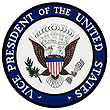Charles G. Dawes
From Wikipedia, the free encyclopedia.
Charles Gates Dawes (August 27, 1865 – April 23, 1951) was the 30th Vice President of the United States.
Dawes, a great-grandson of the Revolutionary War figure William Dawes, was born in Marietta, Washington County, Ohio, and graduated from Marietta College in 1884 and from the Cincinnati Law School in 1886. He was admitted to the bar in that year and practiced in Lincoln, Nebraska 1887-1894. Dawes was interested in public utilities and banking 1894-1897, Comptroller of the Currency, United States Department of the Treasury 1898-1901. He was an unsuccessful candidate for the United States Senate in 1902.
During the First World War, Dawes was commissioned major, lieutenant colonel, and brigadier general of the Seventeenth Engineers. He served with the American Expeditionary Force as chief of supply procurement and was a member of the Liquidation Commission, United States War Department. He resigned from the Army in 1919, and upon the creation of the Bureau of the Budget was appointed its first Director in 1921. He was appointed to the Allied Reparations Commission in 1923. For his work on a program to enable Germany to restore and stabilize its economy, Dawes shared the Nobel Peace Prize in 1925.
Dawes was elected on November 5, 1924, Vice President on the Republican ticket with President Calvin Coolidge and was inaugurated March 4, 1925 for the term ending March 3, 1929.
He was U.S. ambassador to the Court of St. James's (that is, to the United Kingdom) from 1929 to 1932, and resumed the banking business and was chairman of the board of the City National Bank and Trust Co., Chicago, Illinois, from 1932 until his death in Evanston, Illinois. He is interred in Rosehill Cemetery, Chicago, Illinois.
Charles Dawes was also a self-taught pianist and composer. The pop song "It's All In The Game" was an adaptation of Dawes's 1912 composition "Melody in A Major," with lyrics written in 1951 by Carl Sigman. The song was later recorded by such artists as Tommy Edwards, Van Morrison, Cliff Richard, and Elton John.
External links
- Evanston Historical Society, headquartered in the lakefront Dawes house
| Preceded by: Calvin Coolidge |
Republican Party Vice Presidential candidate 1924 (won) |
Succeeded by: Charles Curtis |
| Preceded by: Calvin Coolidge |
Vice President of the United States March 4, 1925 – March 3, 1929 |
Succeeded by: Charles Curtis |
| Vice Presidents of the United States of America |  |
|---|---|
| Adams | Jefferson | Burr | Clinton | Gerry | Tompkins | Calhoun | Van Buren | R Johnson | Tyler | Dallas | Fillmore | King | Breckinridge | Hamlin | A Johnson | Colfax | Wilson | Wheeler | Arthur | Hendricks | Morton | Stevenson | Hobart | Roosevelt | Fairbanks | Sherman | Marshall | Coolidge | Dawes | Curtis | Garner | Wallace | Truman | Barkley | Nixon | L Johnson | Humphrey | Agnew | Ford | Rockefeller | Mondale | Bush | Quayle | Gore | Cheney |
| Directors of the United States Office of Management and Budget |  |
|---|---|
| Dawes | Lard | Roop | Douglas | D.W. Bell | Smith | Webb | Pace | Lawton | Dodge | Hughes | Brundage | Stans | D.E. Bell | Gordon | Schultze | Zwick | Mayo | Shultz | Weinberger | Ash | Lynn | Lance | McIntyre | Stockman | Wright | Miller | Wright | Darman | Panetta | Rivlin | Raines | Lew | Daniels | Bolten |

